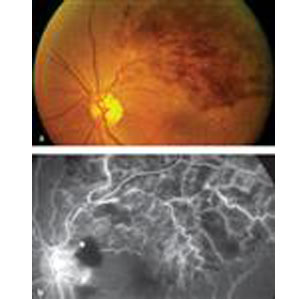Copyright © 2014: Manila Retina Specialists All Rights Reserved
 Fig 12 Branch vein OcclusionBranch or Central Vein Occlusions
Fig 12 Branch vein OcclusionBranch or Central Vein Occlusions
This is usually heralded by the sudden onset of blurred vision, which can be total, in case of Central Vein Occlusion, or partial ( in case of branch vein occlusion). This is caused by a thrombus, or clot, that lodges in the veins (blood vessels that carry blood out of the eyes). Certain illnesses predispose to this condition, like diabetes or hypertension, but it may be simply an aging phenomenon. Those who use oral contraceptives, or smoke have a higher chance of developing this disorder.
We usually ask for an Optical Coherence Tomography (OCT) to see if there is swelling in the macula. If there is, you may have the option of undergoing anti-VEGF injections. Multiple injections may be needed to completely dry the retina. It usually consists of a more frequent loading phase, and less frequent maintenance phase may be needed.
Option of steroid injections (Ozurdex implant) are also given as primary treatment, or as alternative to those with recurrent edema, particularly in patients that already had cataract surgery. Its advantage is that it can be given less frequently, as in 2- 3 x a year only, depending on the response.
